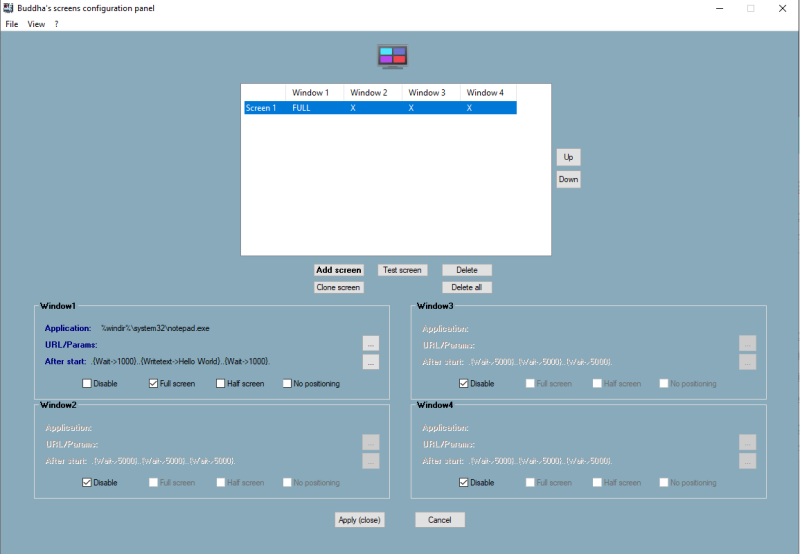1. Get the application
1.1 Download Buddha's screens
1.2 Unzip to a directory place
-Right click on the zipped file --> Open wth --> Windows explorer
-Right click on "Buddha screens manager" directory --> Copy
-Copy to your favorite directory ( eg. 'c:/' or 'c:/MyPortableApps' or ... )
1.3 Open configuration Panel
On your copied 'Buddha screen manager' directory you should find 2 executables:
-'StartBuddha.exe' and 'ConfigurationPanel.exe'
-Double click on 'ConfigurationPanel.exe'

1.4 Play demo screen
Press the button 'Test screen', it will execute the selected screen on the list.

!! During the exécution don't touch your keyboard or your mouse !!
(this will interfere with the good execution of the automation)
2. Get a new configuration
2.1 Delete demo screen

2.2 Add new screen

2.3 Activate a window
Select 'Screen 1' on the list

Uncheck disable option

2.4 Select an application to lunch (Optional)
Press first button on the right part into Window1 section

You can choose between 'Web application' or 'Desktop application'

2.5 Add some actions to do after the application start (Optional)
Press second button on the right part into Window1 section

You can build a sequence of actions to do.

( You have to keep in mind that a lot of actions will be done in the current focused window, so 'Change focus', 'Wait focus' or a simple 'Wait' can help you to get the good window focus and 'PRESS TAB' can help to get the good input box on the focused window ! )
2.6 Choose an auto-positioning mode
By default the Buddha's screens will move the current focused window as follow :

But you can choose between

2.7 Save a new configuration file
Once you have finish the configuration, you can save the configuration to the default configuration file or to a external configuration file

3. Execute a specific configuration file
By default, when you execute 'startBuddha.exe' it will take the default configuation file find in the Buddha screens manager directory --> multiscreenConfig.txt
But you can start the executable with a external config as parameter
3.1 With Windows terminal

3.2 With a desktop shorcut
Right click on your desktop --> New --> Shortcut

4. All available post execution actions
3.1 Free version

3.2 Pro version





